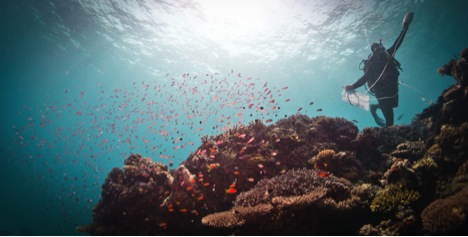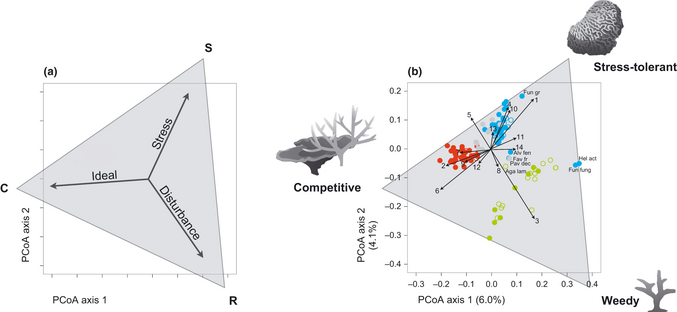Below is a guest post (her first!) by Dr Emily Darling, about one of the 17 chapters of her PhD dissertation:
The ongoing loss of coral cover and flattening of reef architecture is leading to dramatic and drastic changes for coral reef ecosystems. But not all reef-building corals are affected in the same way. We know that some species are winners and others are losers – but which ones, and why? Corals are the backbone of tropical reefs – identifying changes in their species diversity and composition can help scientists and managers understand what future reefs will look like, and the function and services that reefs can continue to provide.
 The biggest hurdle to understanding changes in coral communities is that there are hundreds of different species of scleractinian corals (and a lot of them look alike and are tricky to identify!) We wanted to find a way to simplify the remarkable diversity of scleractinian corals. Classic work in ecology suggests there may only be a few ways that organisms ‘make a living’ in order to survive, grow and reproduce. These fundamental characteristics (and their trade-offs) describe an organism’s life history. With this in mind, we looked for major life histories of reef-building corals.
The biggest hurdle to understanding changes in coral communities is that there are hundreds of different species of scleractinian corals (and a lot of them look alike and are tricky to identify!) We wanted to find a way to simplify the remarkable diversity of scleractinian corals. Classic work in ecology suggests there may only be a few ways that organisms ‘make a living’ in order to survive, grow and reproduce. These fundamental characteristics (and their trade-offs) describe an organism’s life history. With this in mind, we looked for major life histories of reef-building corals.
Where did we look? We headed for the scientific literature and pulled together bits and pieces of data from published articles, taxonomic descriptions and species identification guidebooks on 11 different species characteristics for reef corals all over the world.
We found evidence for up to four major ‘lifestyles’ of reef corals, which we called competitive, stress-tolerant, weedy, and generalist. Each life history has unique characteristics that can allow species to cope with different environments.
- Competitive corals can grow fast and create canopies that overtop slower growing corals – these corals do really well in good conditions, but not so well when the going gets tough, such as in harsher environments or after disturbances like hurricanes or coral bleaching.
- Stress-tolerant corals employ a different strategy by growing slowly and living a long time – these species also seem to cope better with harsher environments, like less light on deeper reefs.
- Weedy corals ‘live fast and die young’ – these are smaller corals that produce baby corals by a type of reproduction called brooding – this might help these pioneer species quickly colonize space that opens up after disturbances.
- And finally a handful of species have a ‘grab bag’ of characteristics and share features in common with all three of the other groups – we called these corals ‘generalists’.
 Figure 3 from Darling et al. 2012. Grime’s triangle of life-history strategies applied to reef corals. (a) The conceptual framework of Grime’s three primary life-history strategies and the hypothetical environmental conditions associated with each strategy. (b) Principal Coordinates ordination of 143 coral species with four life-history strategies (red: competitive, green: weedy, blue: stress-tolerant, grey: generalist). Open circles are Atlantic taxa and filled circles are Indo-Pacific taxa. Arrows indicate trait loadings; traits are numbered from most important to least important in differentiating the life-history strategies: 1) domed morphology; 2) growth rate; 3) brooding reproduction; 4) fecundity; 5) broadcast spawning reproduction; 6) branching morphology; 7) colony size; 8) skeletal density; 9) plating morphology; 10) corallite diameter; 11) depth; 12) symbiont diversity; 13) generation length; 14) solitary colonies
Figure 3 from Darling et al. 2012. Grime’s triangle of life-history strategies applied to reef corals. (a) The conceptual framework of Grime’s three primary life-history strategies and the hypothetical environmental conditions associated with each strategy. (b) Principal Coordinates ordination of 143 coral species with four life-history strategies (red: competitive, green: weedy, blue: stress-tolerant, grey: generalist). Open circles are Atlantic taxa and filled circles are Indo-Pacific taxa. Arrows indicate trait loadings; traits are numbered from most important to least important in differentiating the life-history strategies: 1) domed morphology; 2) growth rate; 3) brooding reproduction; 4) fecundity; 5) broadcast spawning reproduction; 6) branching morphology; 7) colony size; 8) skeletal density; 9) plating morphology; 10) corallite diameter; 11) depth; 12) symbiont diversity; 13) generation length; 14) solitary colonies
Classifying corals into these few life histories can help us understand and predict how coral communities are changing both now and into the future. For examples, we are seeing evidence that human activities, notably fishing and climate change, have left a fingerprint on coral communities, by removing sensitive competitive species and leaving only more ‘hardy’ species with stress-tolerant and weedy life histories.
What does this mean for fishes and other organisms that depend on coral reefs? Probably not good things. Large, branching and plating competitive corals provide critical habitat and reef architecture for reef fishes and other invertebrates – the loss of these corals can affect the foundation of the rest of the ecosystem, like clear-cutting old growth trees in a rainforest. Overall, I hope our life history approach is a straightforward tool that can help understand how species of reef-building corals are changing and the implications for coral reef ecosystems and the economies they support.
Our paper is called Evaluating life-history strategies of reef corals from species traits and was published in Ecology Letters. You can find it here.
Abstract: Classifying the biological traits of organisms can test conceptual frameworks of life-history strategies and allow for predictions of how different species may respond to environmental disturbances. We apply a trait-based classification approach to a complex and threatened group of species, scleractinian reef corals. Using hierarchical clustering and random forests analyses, we identify up to four life-history strategies that appear globally consistent across 143 species of reef corals: competitive, weedy, stress-tolerant, and generalist taxa, which are primarily separated by colony morphology, growth rate and reproductive mode. Documented shifts towards stress-tolerant and weedy species in coral reef communities are consistent with the expected responses of these life-history strategies. Our quantitative trait-based approach to classifying life-history strategies is objective, applicable to any taxa, and a powerful tool that can be used to evaluate theories of community ecology and predict the impact of environmental and anthropogenic stressors on species assemblages.
Leave a Reply